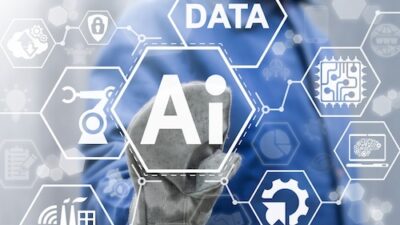“There is a lot of uncertainty,” Singh remarked during an interview with CNBC-TV18. “As a parent of a soon-to-be computer science graduate, I have my concerns. However, success hinges on being an effective problem solver and maintaining mental flexibility. If we’re to remain hopeful, we must believe that, despite disruptions, society will ultimately benefit.”
He asserts that the AI revolution has the potential to enhance systems for everyone: “We should aim to deliver superior education, healthcare, and financial services.”
Nevertheless, Singh recognized that not everyone shares this enthusiasm. “As technologists, we are thrilled, but there are individuals apprehensive about job losses,” he said. “For innovation to genuinely affect businesses and individuals, substantial change management is necessary.”
Reflecting on the rapid advancements in the AI landscape, including hardware, language models, and end-user applications, Singh noted, “Everything is changing rapidly. Nvidia has undergone significant transformations… even OpenAI didn’t anticipate this level of demand.”
Dev Khare, Partner at Lightspeed, mentioned that the groundwork has been established over the past three years. “A lot of the infrastructure, foundational models, security measures, and tools are largely developed. I believe the upcoming years will focus on the ‘application’ layer—what can be constructed on this foundation,” he commented.
Here is an excerpt from the interview.
Q: I was discussing the Lightspeed Wisdom Tree and how you’ve almost traced your origins and roots here, Ajeet, in numerous ways.
Singh: Yes, this office is quite significant. It serves as a professional home for me. As we discussed, behind you are the very offices where we launched ThoughtSpot. For two months, three of us operated from there. In another corner, there’s the office where we finalized Nutanix’s Series A term sheet. Many of our pitches took place in these offices. I have a wealth of fond memories and am deeply appreciative of the partnership we’ve cultivated with the Lightspeed team over the years—decades, in fact.
Q: But Dev, the energy and the “vibe,” and returning to Ajeet’s point—the stories you hear from founders about their beginnings, about their significant breakthroughs—what stands out most for you?
Khare: I joined Lightspeed in 2011 and remained until I moved back to India. Coming here, I met numerous investors I recognized but had not encountered, as well as these companies—such as ThoughtSpot and Nutanix in the following years. This was also the inception of the crypto boom. I recall Bitcoin being valued at $13 at that time, and we debated how to leverage that trend over the next decade or so. The Valley has witnessed countless changes, and we’ve been fortunate to be part of it.
Q: That leads perfectly into our discussion. You mentioned crypto and Bitcoin—contrasting where it was a decade ago to where we are now, especially with the resurgence due to Trump promoting cryptocurrencies. What are your thoughts on this resurgence?
Khare: It seems we’ve experienced numerous crypto summers and winters over the past ten years. Much of that revolves around Bitcoin, but many other assets exist. Additionally, the entire infrastructure supporting cryptocurrency—all the exchanges, wallets, etc.—has gone through fluctuations. We believe, through these cycles, the ecosystem is integrating into the economy. Significant areas like stablecoins promise a robust infrastructure for building many financial services. We’re actively tracking and investing in these trends both here and in Asia, particularly in cities like Dubai and Singapore with their favorable crypto regulations, leading to considerable innovation.
Q: Ajeet, let’s delve into your journey between Nutanix and ThoughtSpot. I’d like to revisit your backstory—what ignited your entrepreneurial spirit, from IIT Kanpur to IIM, to stepping into the startup arena without prior connections?
Singh: Indeed, it was entirely unplanned. My grandparents and many uncles were farmers, and I’d spend summers in Muzaffarnagar village. No one in my family had ventured into business. However, in my first job, I discovered my passion for creating new things or engaging in projects that required innovative thinking. The first ten years of my career were in large enterprises, yet I constantly sought opportunities to innovate. Arriving in the Valley in 2007 was eye-opening; I felt incredibly fortunate to be amidst people who thrive on starting from scratch. Investors like Lightspeed are willing to make substantial bets, and many individuals willingly leave stable jobs to pursue untested ideas. After a brief stint at Oracle, I jumped into a startup, gained valuable experience, and then, along with my co-founders, decided to launch Nutanix. Worst case, we’d find new opportunities after six months. I didn’t want to look back at 60 with regrets; like everyone else, I have some regrets, but this isn’t one I wanted to harbor.
Q: Observing the current happenings in the Valley, particularly the surge of interest in AI, we’ve discussed seasons of change. How do you perceive the current AI explosion, especially with Lightspeed’s recent significant investment in Anthropic?
Khare: Over the past decade, there’s been a continuous narrative around the arrival of AI—and with GPT-3.5, we finally crossed that pivotal threshold three years ago. The innovation pace has only accelerated since then. The last three years have largely focused on establishing the necessary groundwork for AI—covering infrastructure, foundational models, security, and tools. The upcoming years will primarily emphasize the applications that can emerge from this foundation. Some label them as agentic services. There’s a lot on the horizon now, which is where investor interest is intensifying—what can genuinely materialize on the established infrastructure.
Q: But Ajeet, whether it’s agentic AI or the explosion of data centers and beyond—what differentiates this wave from previous ones?
Singh: In terms of AI being a groundbreaking wave, what sets it apart is that every aspect of the stack is undergoing rapid changes. By “stack,” I refer to everything from hardware through to end users. We’ve got hardware, large language models—view them as a compute model—followed by platforms enabling applications built on these LLMs, and the applications themselves. The pace of change is remarkable. Nvidia has notably undergone massive shifts in recent years. New hardware companies are emerging to focus on inferencing, a significant aspect of AI consumption. Even OpenAI didn’t foresee this level of demand. There’s substantial investment pursuing that efficiency.
We’re also witnessing innovations in LLMs, with multimodal models like DeepSeek introducing new compute strategies. Costs are declining while capabilities rise. Companies like Glean enable the development of applications atop this infrastructure, while firms like ThoughtSpot provide end-user applications leveraging these advancements. On one side, it’s an exhilarating period in tech. I feel immensely lucky to be part of this era and location.
Conversely, there’s an overwhelming amount of change to navigate. For this innovation to genuinely influence businesses or individuals, significant change management will be essential.
Recently, I met with a leading executive from one of the premier US banks, who expressed the challenges of integrating innovation into deeply regulated environments. They contend with governance, controls, and sensitive data—making it impossible to expose that to external parties. Therefore, while it’s thrilling, it can also be disruptive. Those who flourish in changing environments will find it exciting, but many individuals may feel unsettled. There’s a prevalent fear surrounding job losses, and while we technologists are enthusiastic, we need to acknowledge that apprehension.
Q: That fear is very real. Even AI companies like Anthropic are warning of potential white-collar job losses. The competition among companies to determine how much code machines generate is intensifying. I spoke with OpenAI’s Chief Product Officer, who indicated we might see machine-generated code reach 100% in mere months. When discussing change, this is a truly accelerated pace.
Singh: Indeed, there’s considerable uncertainty. As a parent of someone about to earn a computer science degree, I share the same concerns about job prospects.
Q: What advice are you offering him?
Singh: It revolves around being a proficient problem solver and maintaining adaptability. The future landscape is unpredictable—we can argue about whether changes will manifest in one year or 18 months. However, in over three years, we anticipate significant transformations across various industries. Optimistically, we must believe that, despite upheavals in specific sectors, society will benefit overall. Reskilling will be needed, and some jobs will be lost—but fundamentally, we should enhance education, healthcare, and financial services for the underserved. Therefore, I’m ultimately optimistic about the long-term outlook.
Q: Dev, at the intersection of change and opportunity, investors like you find rationale for funding. Currently, many large corporations dominate the addressable market across AI sectors. Will this remain a game for the big players, or is there still room for startups?
Khare: There’s ample opportunity for startups and existing application companies from the pre-AI era to adapt and seize the broader opportunities ahead. Historically, every platform shift over the last two decades—like the internet and mobile—has resulted in new leaders and fallers. I believe what’s unfolding now is on an even grander scale.
If you analyze vertical-specific tech firms—those focusing on healthcare, finance, and home services—you’ll find legacy applications prevailing in those industries—like Epic in healthcare, Veeva in life sciences, and ServiceTitan in home services. Traditionally, most investments in these areas have gone toward manual services, with BPOs and IT services benefitting as many tasks couldn’t be automated. However, AI now facilitates greater automation. Startups in these areas are swiftly gaining traction and adoption. Hospitals, insurers, and banks—even small businesses and consumers—are rapidly embracing these solutions.
The total addressable market (TAM) isn’t solely about software expenditure anymore. It also encompasses labor costs. Many of these roles are unappealing, and numerous individuals are retiring. Consequently, technology is stepping in. Nonetheless, this poses a significant threat to certain outsourcing companies.
Q: I’ve conversed with various outsourcing firms, and they don’t perceive this as an existential danger. They believe they’re prepared for change and see this as an opportunity moving forward.
Khare: That’s the standard response. Incumbents tend to say that. They have developed AI divisions over recent years, contributing to their revenues. However, as Ajeet noted, many enterprises struggle to navigate change independently, prompting them to seek assistance—be it through platform or service companies. While opportunities exist, we believe some of these startups are more agile and may have the potential to disrupt certain vertical markets.
Watch the accompanying video for the entire interview.



